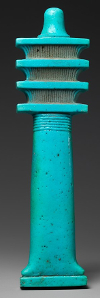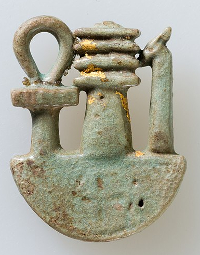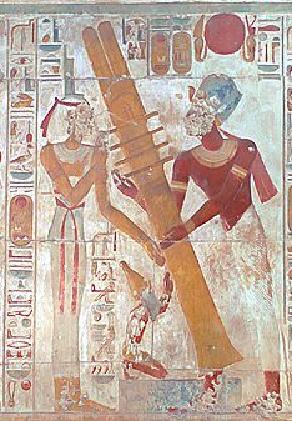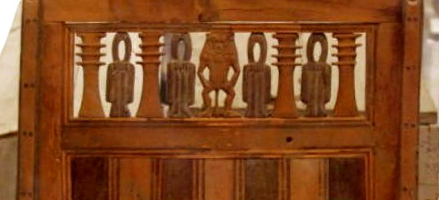
The Djed is an ancient Egyptian symbol that resembles a column with a broad base, which is divided by four parallel bars. The Djed pillar was an object of worship from the pre-dynastic period, giving its name to the city of Djedu (Busiris, in the 9th nome of Lower Egypt). It is clearly a stylised image, but there is disagreement regarding the origins of the symbol. As a hieroglyph, it came to represent stability and durability, but may have started out as a fertility fetish.

It is suggested that the Djed represented a cedar tree with its branches removed, the pole to which sheaves of grain were tied after harvest, or a stylised sheaf of corn. Alternatively, the symbol may have represented four pillars of increasing size, seen one behind the other. In Sneferu’s step pyramid, the Djed pillars form columns supporting the sky and may represent the four pillars which help Shu bear the sky on his shoulders. Finally, the Djed may represent a man’s backbone (that of either Sokar or Osiris). Some commentators, however, have come up with some distinctly speculative meanings and functions for the Djed. Some describe it as an electrical device with insulators, while others suggest that it was a power generator (e.g. in the “Denderah lightbulb”). It has also been suggested that it is a remnant from an early cattle worshipping culture and represented the spine of a bull.

During the Old Kingdom, the Djed was associated with Ptah, (the creator god of Memphis), who was given the epithet “the Noble Djed”. Later, it became more closely associated with Osiris (particularly in his form as Banebdjed). In the story of Isis and Osiris, the Djed pillar is Osiris’ backbone which Isis found buried in Djedu. The city was renamed Pr-Asir (“the house of Osiris”) which the Greeks translated as Busiris. In one variant, the Djed is the pillar formed from the tree that grew around Osiris’ corpse and was raised by the King of Byblos and used to support his palace. Isis travelled to Byblos and cured the king’s son of a potentially fatal illness in order to get the pillar back. When Osiris absorbed the god Sokar, he too became associated with the Djed.

There was an annual festival during the month of Koiak which celebrated the murder of Osiris by Set, and the later resurrection of Osiris. On the last day of the festival the pharaoh performed a ceremony called “raising the Djed”. It is thought that this ceremony emphasised the stability of the monarch, and symbolized the rebirth of Osiris.
The Djed is often found with the “Ankh”, the “Was” scepter and the “Tjet” and was often incorporated into an amulet to utilize its protective powers.
Copyright J Hill 2010